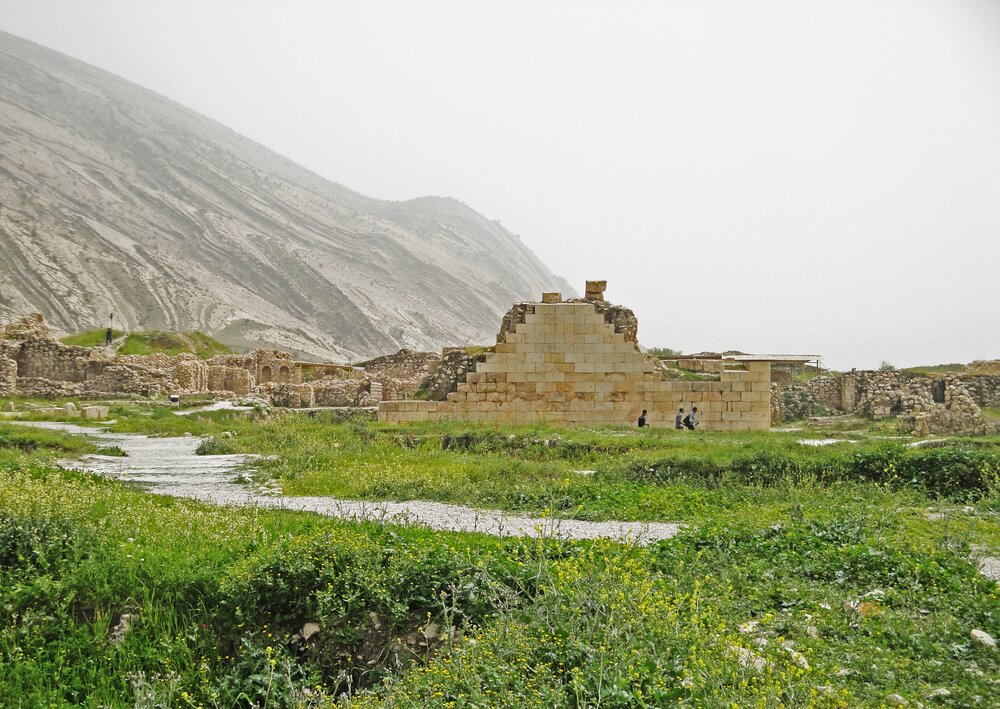Bishapur’s Anahita Temple insulated

TEHRAN – An insulation work has recently been completed on the ancient temple of Anahita in Bishapur, southern Fars province, a local tourism official has announced.
One of the unique remnants of the early Sassanid era (224 CE–651), the temple was insulated to prevent water from penetrating its corridors, Mohammad Salehpour said on Monday.
Over a period of three weeks, cultural heritage experts insulated the roof of the monument with mud and lime materials, the official added.
The Anahita Temple is the name of one of two archaeological sites in Iran popularly thought to have been attributed to the ancient deity Anahita. The larger and more widely known of the two is located at Kangavar in Kermanshah province. The other is located at Bishapur.
Anahita, also known as Anaitis, and Anahit, was an ancient Iranian goddess of royalty, water, and fertility; she is particularly associated with the last.
Possibly of Mesopotamian origin, her cult was made prominent by Artaxerxes II, and statues and temples were set up in her honor throughout the Persian empire.
A common cult of the various peoples of the empire at that time, it persisted in Asia Minor long afterward. In the Avesta she is called Ardvi Sura Anahita (“Damp, Strong, Untainted”); this seems to be an amalgam of two originally separate deities, according to Britannica.
In Greece, Anahiti was identified with Athena and Artemis. She is mentioned in the sacred book of Zoroastrianism, the Avesta, note, and three Achaemenid Royal Inscriptions from the reign of Artaxerxes II Mnemon (r.404-358 BCE). There were sanctuaries for Anahita in Bactra, in Ecbatana, in Artaxata, in Zela, and Hierocaesarea, according to Livius.org; a website on ancient history written and maintained since 1996 by the Dutch historian Jona Lendering.
The goddess is also represented in Darabgird and Taq-e Bostan. Modern scholars have suggested that Anahita was also venerated at Kangavar, Qadamgah, and Bishapur, where sanctuaries have been found that can plausibly be identified as water temples. However, not every aquatic deity automatically equates with Anahita, so there is room for doubt.
A glimpse of ancient city of Bishapur
Bishapur (literally, “The city of Shapur”) was the grand capital of the Sassanid king, Shapur I whose armies defeated the Romans three times.
Like an arch bridge at Shushtar, much of Bishapur was allegedly built by Roman soldiers taken captive after their Emperor Valerian was defeated in c. 260 CE.
Bishapur is situated south of modern Faliyan, just off the ancient road between Persis and Elam, which connected the Sasanian capitals Istakhr (close to Persepolis) and Firuzabad to Susa and Ctesiphon. The city was built near a river crossing.
The site has been partly excavated so far, revealing the Palace of Shapur and the nearby Temple of Anahita, where a stairway leads underground to a pool around which the faithful once walked and prayed. Bishapur was not a completely novel settlement: archaeologists have found remains from the Elamite and Parthian ages.
Many architectural aspects of Bishapur look Roman and do not belong to Iranian building traditions. An example is what specialists call the "Hippodamian Plan", which means that the city looks like a gridiron, while Iranian cities usually were circular.
The city, surrounded by walls that may have stood some ten meters high, was inhabited by some 50,000 to 80,000 people.
Bishapur remained an important city until the Arab invasion of Persia and the rise of Islam in the second quarter of the seventh century. It became a center of Islamic learning (a madrassah has been excavated) and there were still people living over here in the tenth century, but the decline had started in the seventh century.
ABU/MG
